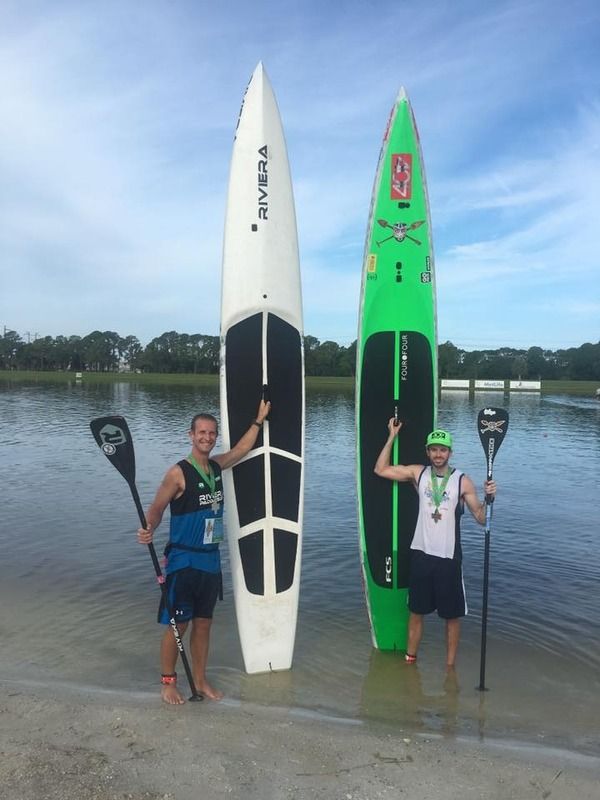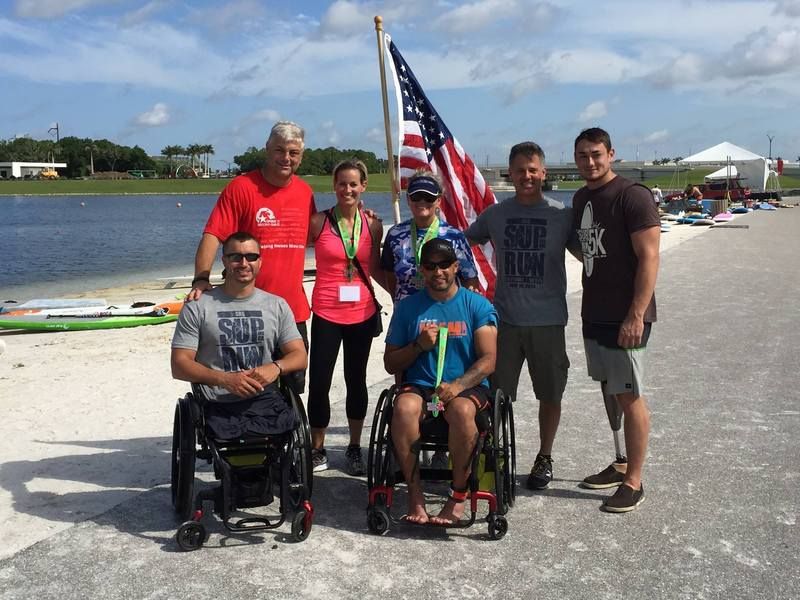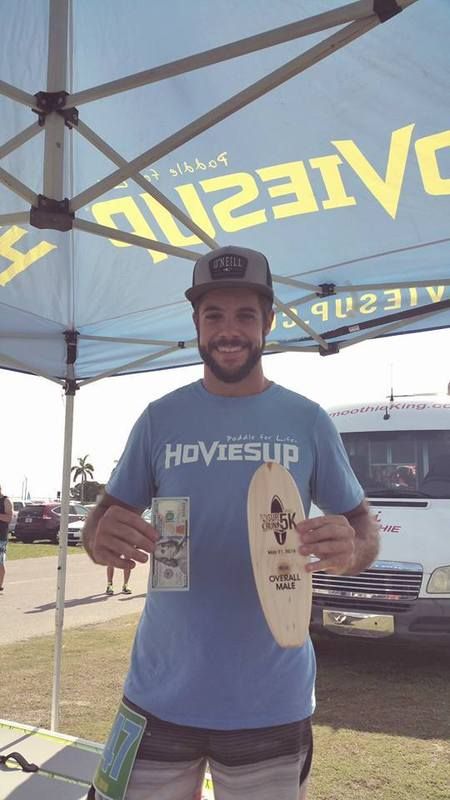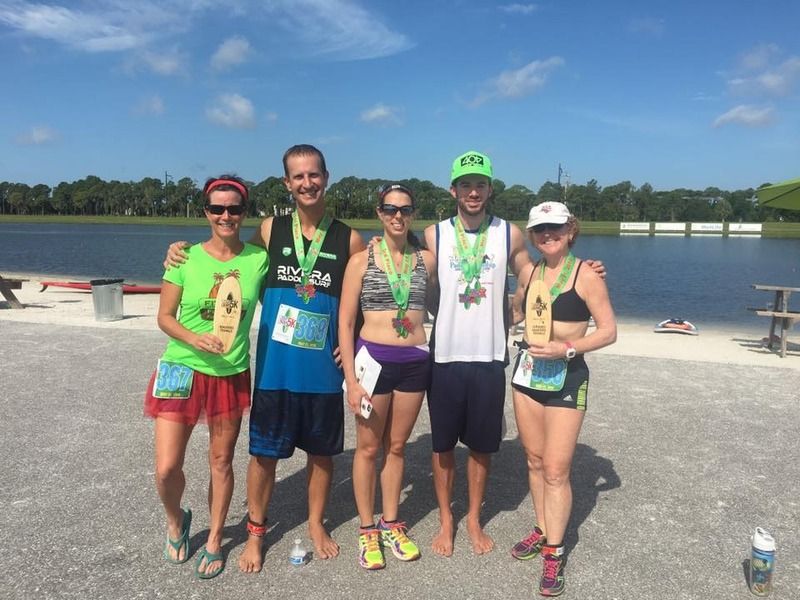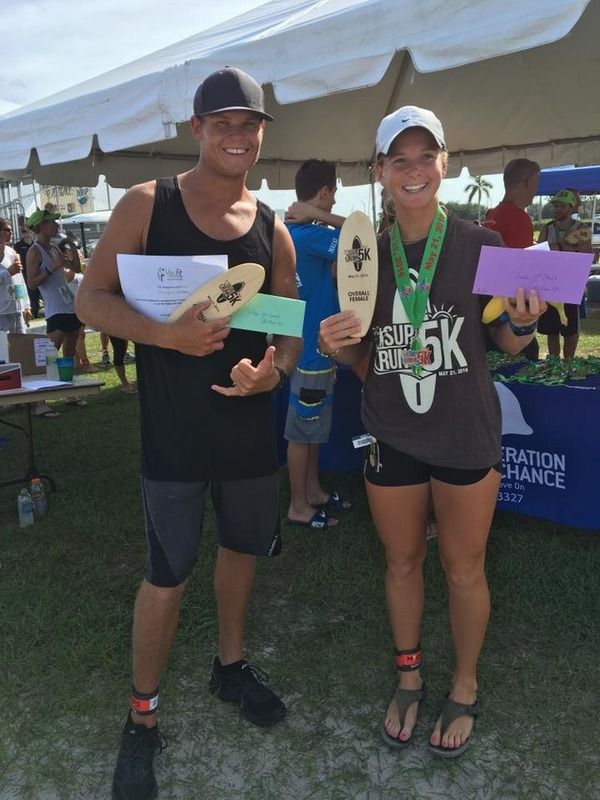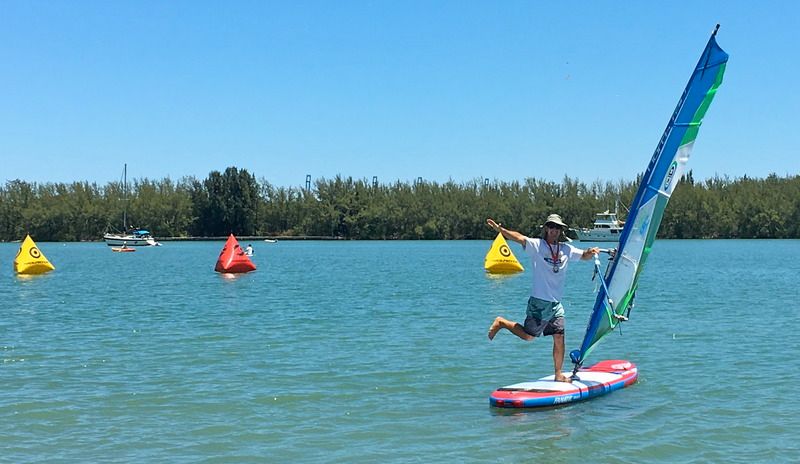 Race
Race: The
Key West Paddle Classic, organized by the
Lazy Dog and sanctioned by the WPA.
Date it happened: 30 April 2016
Location: Higgs Beach, Key West, Florida.
Distance: The main event was a race around the entire perimeter of Key West, approximately 12 miles. I had 18.82 km on my GPS at the end, which is 11.7 miles. There was also a 4 mile race, which was two miles into the wind from Higgs Beach, then two miles back.
Conditions: It was sunny, hot, and humid with a significant ESE wind around 10-15 knots. We started and finished by going downwind, but much of the race was into the wind or sort-of into the wind. There were also strong currents flowing from the Gulf of Mexico to the Atlantic because the tide was ebbing. The currents were against us going through a bottleneck at Fleming Key Cut and were weakly in our favor later when going through Cow Key Channel. There were a variety of shoreline obstacles, shallow water hazards, boat wakes, etc. In a few areas there were dangerous metal pipes, spikes, and pilings half submerged in the path of the race, which could shish-kabab a person who fell on them. I saw at least one guy (Jake Portwood) had some bloody scrapes after the race, but I'm not sure exactly how he got them.
Participants: There was a huge turnout for this race, which is perhaps the highest profile SUP race in Florida. It even attracted some international pros including Kelly Margetts from Australia (
Lahui Kai boards), Vinnicius Martins from Brazil (
JP Boards), Belar Diaz from Spain (
ECS boards), and Larry Cain from Canada (
Starboard). The usual best-in-Florida hotshots were there, including Kieran Grant (
Hoviesup) and Garrett Fletcher (
Yolo Boards), who got 4th and 5th in the mens' 14' class. Young Joey Huemphner (
BOTE/Darkroom boards) got 1st in mens' 12'6, followed closely by Steve Miller (Starboard) and Jake Portwood (
Hoviesup). Seychelle Hattingh (
Mistral) and Kimberley Barnes (
Riviera) were 2nd and 3rd in womens' 12'6, after North Carolina's amazing April Zilg (
Hobie SUP). I traveled to the race and split a room at the Sheraton with my
CGT Race Team buddies Matt Kearney and Devin Turetzkin. Also representing CGT we had the South African Riverbeest Murray Hunkin and his sweetheart Saralane Harrer.
Results: 116 sup racers finished the around-the-island race; 83 men and 33 women. There were also a lot of people who did it on Kayaks, Outrigger Canoes, and various other paddlecraft. Of the sup racers, Vinnicius Martins, Kelly Margetts, and Larry Cain were the top three 14' sups, in 2:04:46, 2:05:06, and 2:07:34, respectively. I finished 10th in the 14' class, with a time of 2:23:00. I was just behind the first place 12'6 (Joey Huemphner) who had 2:22:05, and just ahead of first place woman (April Zilg on a 12'6) who had 2:23:32. My race wasn't perfect (see play by play), but I was pleased to be in the top 10 for my class. My buddy Devin Turetzkin, who just got a new 12'6 x 25" Hovie Comet GT, got first place in the over-50 12'6 class with 3:04:43. Skinny Matt Kearney battled the wind (which is worse for lightweight guys) to an admirable 2:51:09, just behind exercise physiologist Dr. Jose Antonio (the protein doctor guy who we did the study with at Nova Southweastern University). Full results are posted on the
SUP Racer website.
Vinnicius Martins winning.

Kelly Margetts second.

Larry Cain third.

Seychelle Hattingh and Kimberly Barnes 2nd and 3rd

Me at the finish.
 Gear
Gear: I used my usual 14'x23.75" custom carbon Riviera RP raceboard. I tested it out first with a short 6" Fins Unlimited fin, but I felt like I needed more stability in the rough water, so I switched to a 9" windsurfing weed fin, which helped. (Amazingly, I never fell during the race.) I used the Riviera Vantage R8 paddle that I recently cut down to 77". I felt weak in the upwind/sidewind sections of the course and had trouble maintaining a strong/fast/dynamic stroke. It seems like a lot of good racers, even big strong ones like Larry Cain, are now using smaller paddle blades than me, and I think I ought to experiment with that. Also, I need to practice more in upwind/choppy conditions to find the right rhythm and pacing.
Play by play: The race had a very spread-out start, from the water, along an imaginary line perpendicular to the beach. I chose to be pretty far from shore so that I'd have a more directly-downwind shot to the first turn. There was supposed to be a 1 minute warning from a jetski before the start, but I didn't see or hear the warning and I was about 60 meters behind the front of the pack when they blew the starting horn. Doh! Lesson learned- always be at the front of the group ready to go, because you never know exactly when the start is coming.
The first leg of the race was a "downwinder," which I can do, but not skillfully. I can stay upright and intermittently catch bumps that accelerate me to 10-50% over my normal flatwater paddling speed. But I spend a lot of energy balancing, and between the fast "glides" I often drop below normal flatwater speed or get knocked off course. Therefore my average speed in a downwind section is only a bit faster than I would go with the same effort in neutral conditions. In contrast, the pros like Kelly and Vinnicius are really effective at catching every possible glide and maintaining a rocketing average speed downwind. A few minutes after the start they were just specs in the distance to me. At least I didn't fall down, and I worked through the slower part of the pack up to the riders who were about my speed.
The end of the downwind was a rock jetty at Fort Zachary Taylor, where we turned North into the Key West shipping channel. I did ok there by staying close to shore where there was less current, which allowed me to get past Sam English, who was charging hard but too far offshore. I gradually started creeping up on another strong paddler, who I realized was April Zilg on a 12'6. Neither of us could draft the other because it's not allowed, but I passed her (with difficulty) and focused on a couple of male riders who were ahead but still within possible catch-and-draft distance.
The sharp right turn into the strong current of Fleming Key cut was tricky and caused Bill Swezey to fall about 50 meters in front of me. In retrospect I should have given it my absolute everything to catch him at that point but I felt too tired at the time to pull off something like that, and I had my own troubles negotiating the current around the bend.
Fighting that current in Fleming Key Cut sucked big time, even when doing the trick of paddling just an arms' length from the seawall. I wasn't getting any closer to Bill Swezey, and I wasn't get any further from April Zilg. I decided to gamble and cross the channel early to try to escape the treadmill. It could have gone horribly wrong, but it didn't. After squeaking through the nasty current under the Fleming Key bridge, I saw that I had sort of gotten in front of Bill Swezey, Robert Hess, and Belar Diaz. But I was tired, still in a substantial current, and now fighting side-wind and chop coming across a wide open bay. I was also a bit downwind of those three fast guys, and when they crept up on the upwind side I couldn't muster the strength to get over and join their train. I felt very weak and demoralized at this point. My left side paddling muscles hurt from only being able to paddle on that side, my cadence slowed down, and psychologically it felt like every stroke was weighed down with the pain of knowing how much more of the race was still to come, and how much of that would be fighting the wind.
It was a huge relief to get into the smooth water in the lee of Dredgers Key, where I could resume paddling on both sides and regain some kind of rhythm. I was still feeling kind of sorry for myself and in survivor mindset more than killer racer mindset, though. I think this was where Jake Portwood and some other of the fast 12'6 riders got ahead of me, and April Zilg was pulling up next to me, too. The next section was straight into the wind and chop across another open bay into Cow Key Channel. The going was slow, but I started to get a minor second wind. Focusing on counting strokes in my mind helped me find some semblance of a rhythm that adequately advanced me into the wind. It was good seeing the speed go up on my gps as the water smoothed out I got into the tidal current pull of Cow Key Channel. Picking which way to go in the channel was hard, but because the assistance from the tidal current seemed relatively weak I decided to take the shortest path, hugging the west side of the channel. I knew there was a shallow water hazard at the end of that path, but it turned out to be not too bad. That move didn't quite catch me up with the three 12'6 guys who had passed me earlier, but it did get me in front of April Zilg, who had gotten ahead of me in the channel just before I forked off.
The final stretch was about 45 degrees downwind, which is tough. It's hard to properly ride the waves when they're coming at you from that angle. And when you do catch them they tend to carry you off track. Ahead of me I saw the top three 12'6 guys battling hard. Joey Huemphner put on the afterburners and left Steve Miller behind. Jake Portwood fell down several times and lost his lead. My body was worn out and I was focused more on staying upright and pointing in the right direction than on speeding, but I did get some glides, and I managed to pass Jake and Steve near the finish line pier. I put whatever energy I had left into the last 100 meters to the beach, took off my leash at the last second, jumped off and ran through the whatchamacallit finish line thing like I meant it. Woo hoo!
Here's my speedcoach track and data from the race: You have to click into it to see the details like heartrate and stuff.
Other race intrigues: Some weird paddlecraft finished the race, including a giant canoe-catamaran thing with several people in each hull. That thing actually finished in 2:03, before the fastest paddleboard. A much slower multi-paddler inflatable paddleboard called a supsquatch got around the island in 4:16, which I think included a beer break. Individual paddlers continued to the finish the race all afternoon, the last few taking more than 7 hours to complete it on non-race sups. That's determination. Given the distance and the conditions, I'd say this was a race where simply finishing, regardless of how long it took, was a darn good achievement.

It was fun meeting new people at the race, including some friendly paddle celebrities like Olympic canoeists Jim Terrell (owner of
Quickblade Paddles) and Larry Cain. The sport of standup paddleboarding is lucky to have both of these guys involved. Terrell has really put a lot into the paddle design and stroke technique analysis side of things with his Quickblade business, and he has also shaped some crazy raceboards that have pushed the limits of the sport. The board he used in the Key West race was his own design and looked pretty cool. Larry Cain is also into the technical side of paddling and has lots of detailed technique tutorials and equipment commentaries on his
blog. He's also known for having kept himself in ultra-fit shape even decades after his Olympic canoeing days, and he gives some really interesting athletic training advice on his website. Murray from the CGT team knew Larry because they had trained at the same canoe club in Canada, so he introduced us. Though he's intimidating looking, with arms like oak trees and a torso as broad as a manta ray, he was relaxed and friendly when we talked with him. He was even patient with me while I picked his brain about some gear and training questions that had been on my mind.
 What's Next:
What's Next: This race made me realize I need to work on both physical and mental aspects of my upwind power and long-race endurance. Lately my training has been almost all short-distance high intensity stuff in flat water, alternated with a couple days per week of strength training with weights. This approach has definitely improved my short-to-medium-distance race speed, and I think the strength training (which I'm still in the early phases of) will ultimately also help my muscular endurance for upwind and long races. I don't feel out of breath when going upwind or in the second hour of a long race. It's more that I feel enervated, like my strength is drained and I'm paddling through molasses. I need to toughen up and get my mind and body used to maintaining race pace for a long time and in bad conditions. I'll have to experiment to see what the best way to do that is. On this matter Mark Athanacio and Larry Cain have different opinions. Athanacio advocates intense, relatively short workouts that quickly produce exhaustion and train you to maintain speed through that exhaustion. An example would be paddle sprints in the ocean interspersed with beach runs in the soft sand. I'm less familiar with how Larry trains himself and his athletes- I think there are some similarities with what the two experts do, but a big difference is that Larry includes lots of "volume," with long time, long distance paddles. Larry's reason for doing the volume is to build a "base" so that the distance part of long distance races becomes easy for you, and Athanacio's reason for avoiding it is to prevent injuries and overtraining symptoms. I suspect it's one of those things where there's some truth to both views, and the most effective type of training may vary by the individual and what kind of mind and body they have. One thing that Athanacio and Larry agree on, though, is that people who ONLY train with steady long distance paddling never get faster, so the high intensity intervals have to be part of what you do.
